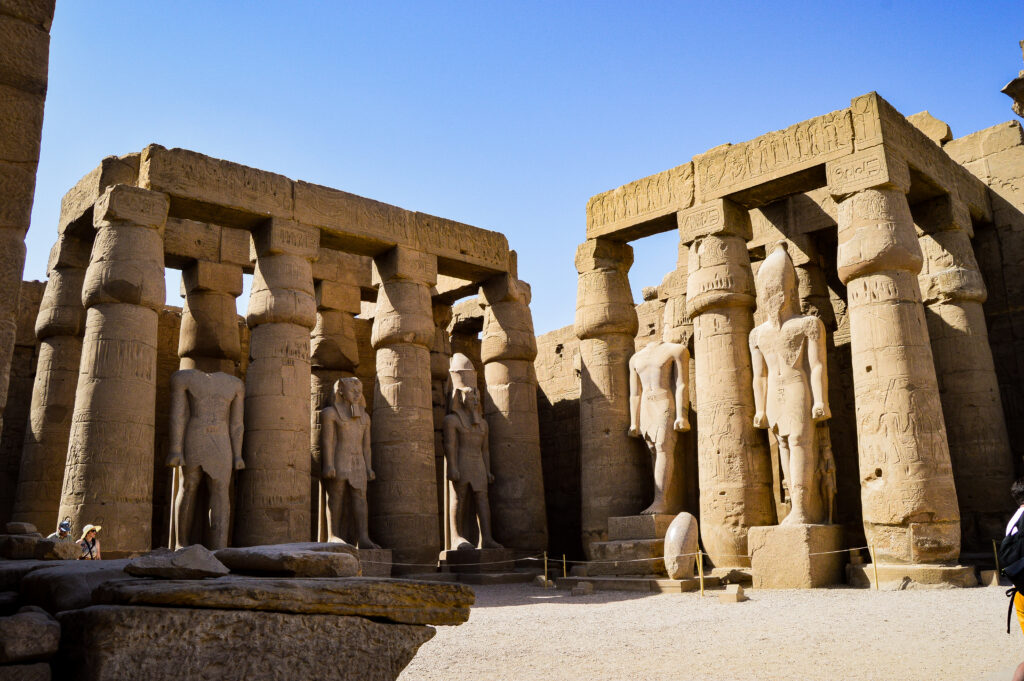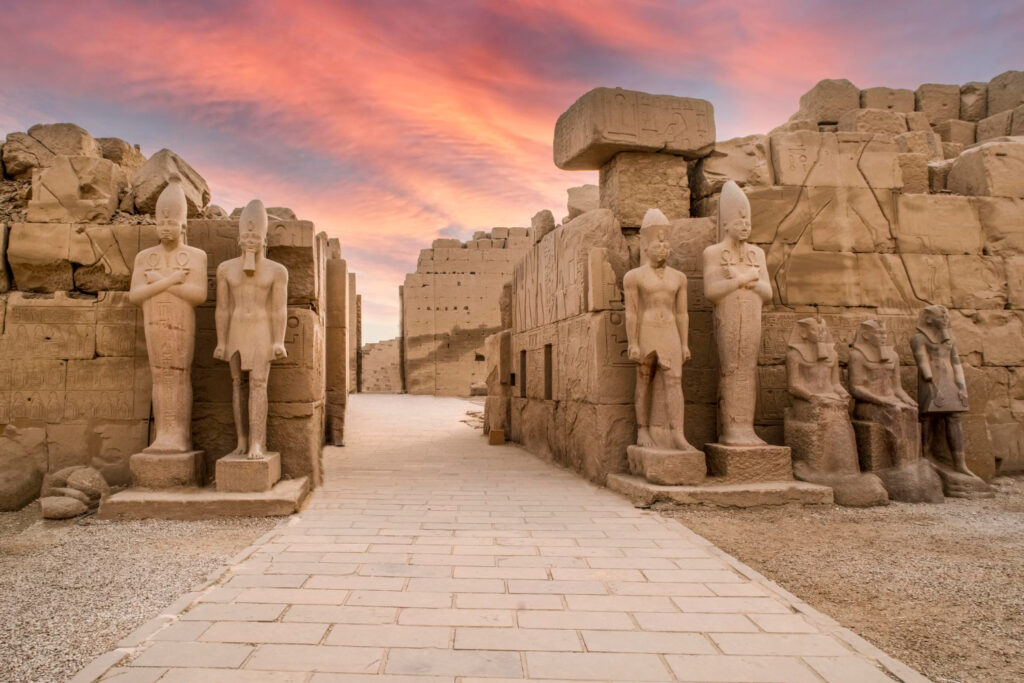Steeped in history, mythology, and architectural marvels, Egypt has long been a favorite destination for travelers seeking to uncover the secrets of an ancient civilization. In 2023, the land of the Pharaohs beckons visitors to explore its enchanting landscapes, fascinating culture, and archaeological treasures. From the majestic pyramids to serene oases, Egypt’s mystical places offer an unforgettable experience for history buffs, adventure-seekers, and everyone in between. Let’s embark on a journey through time and discover the magic of these 17 must-visit destinations in Egypt in 2023.
The Great Pyramids of Giza
The Great Pyramids of Giza, located on the outskirts of Cairo, are among the most iconic and recognizable structures in the world. As one of the Seven Wonders of the Ancient World, the pyramids have captivated travelers for centuries. They are a testament to the ingenuity and architectural prowess of the ancient Egyptians.
There are three main pyramids in the Giza complex:
- The Great Pyramid of Khufu: The largest of the three pyramids, the Great Pyramid was built for Pharaoh Khufu around 2580-2560 BCE. Standing at 481 feet (147 meters) tall, it was the tallest man-made structure in the world for over 3,800 years. Composed of over 2.3 million limestone and granite blocks, this massive structure is an engineering marvel.
- The Pyramid of Khafre: Built for Pharaoh Khafre, son of Khufu, this pyramid is slightly smaller than the Great Pyramid but appears taller due to its elevated location on the plateau. It retains some of the original limestone casing at its apex, giving visitors an idea of how the pyramids would have looked when they were first built.
- The Pyramid of Menkaure: The smallest of the three pyramids, the Pyramid of Menkaure was built for Pharaoh Menkaure. Despite its smaller size, it is still an impressive sight, standing at 213 feet (65 meters) tall.
In addition to the pyramids, the Giza complex is home to the Great Sphinx, a colossal limestone statue with the body of a lion and the head of a human, believed to represent Pharaoh Khafre. The Sphinx is a symbol of ancient Egypt and remains shrouded in mystery, as its origins and purpose are still debated by scholars.
A visit to the Great Pyramids of Giza is an essential experience for any traveler to Egypt. Explore the pyramids’ interiors, where you can navigate through narrow passages to reach the burial chambers, and learn about the complex process of pyramid construction. As you stand in the shadow of these awe-inspiring structures, you’ll be transported back in time to an era of powerful pharaohs and monumental achievements.
Luxor Temple
 The Luxor Temple is an awe-inspiring monument dedicated to the Theban Triad: Amun, Mut, and Khonsu. It’s a masterpiece of ancient architecture that will transport you back to the time of the pharaohs.
The Luxor Temple is an awe-inspiring monument dedicated to the Theban Triad: Amun, Mut, and Khonsu. It’s a masterpiece of ancient architecture that will transport you back to the time of the pharaohs.
Located on the east bank of the Nile River, Luxor Temple is one of Egypt’s most impressive and well-preserved ancient monuments. Constructed around 1400 BCE, the temple was dedicated to the Theban Triad of gods – Amun, Mut, and Khonsu. The temple played a significant role in ancient Egypt, as it was the site of the annual Opet Festival, a celebration where the statues of the Theban Triad were paraded from Karnak Temple to Luxor Temple, reenacting the myth of the divine birth of the pharaoh.
Luxor Temple is a breathtaking example of ancient Egyptian architecture, featuring a variety of structures and decorative elements. Key highlights of the temple include:
- The Avenue of Sphinxes: This impressive avenue once connected Luxor Temple to Karnak Temple, spanning nearly 1.7 miles (2.7 kilometers) and lined with over 1,000 sphinx statues. Today, a portion of the avenue remains at the entrance to Luxor Temple, where visitors are greeted by these majestic guardians.
- The First Pylon: The monumental entrance to Luxor Temple is marked by the First Pylon, a massive sandstone wall adorned with reliefs depicting pharaohs such as Ramesses II and Nectanebo I. Two colossal seated statues of Ramesses II and a large granite obelisk flank the entrance, while a second obelisk (now in Paris) originally stood here as well.
- The Great Court of Ramesses II: Beyond the First Pylon lies the expansive Great Court of Ramesses II, surrounded by walls decorated with scenes of the pharaoh making offerings to the gods. The court also contains a series of colossal statues of Ramesses II and a small chapel dedicated to the goddess Mut.
- The Colonnade of Amenhotep III: This impressive colonnade, built by Amenhotep III, features 14 massive papyrus-shaped columns, intricately carved and towering 52 feet (16 meters) high. The walls of the colonnade are adorned with reliefs illustrating the Opet Festival and the divine birth of Amenhotep III.
- The Sanctuary of Amun-Ra: The heart of Luxor Temple, the Sanctuary of Amun-Ra once housed the sacred statue of the god Amun. The chamber is built from red granite and features beautiful carvings and inscriptions detailing religious rituals and offerings.
Luxor Temple is a must-visit destination in Egypt, offering a glimpse into the grandeur and mystique of ancient Egyptian religion and culture. A visit to this remarkable monument, particularly when illuminated at night, is an unforgettable experience that will transport you back to the time of the pharaohs.
Karnak Temple Complex
 The Karnak Temple Complex, located in the ancient city of Thebes (modern-day Luxor), is the largest religious site from the ancient world. Spanning over 200 acres (81 hectares), the complex consists of a vast array of temples, chapels, pylons, and other structures dedicated to various Egyptian deities, with the primary focus on the god Amun-Ra. Constructed and expanded by successive pharaohs over a period of 1,500 years, Karnak is a treasure trove of ancient Egyptian architecture and art.
The Karnak Temple Complex, located in the ancient city of Thebes (modern-day Luxor), is the largest religious site from the ancient world. Spanning over 200 acres (81 hectares), the complex consists of a vast array of temples, chapels, pylons, and other structures dedicated to various Egyptian deities, with the primary focus on the god Amun-Ra. Constructed and expanded by successive pharaohs over a period of 1,500 years, Karnak is a treasure trove of ancient Egyptian architecture and art.
Some of the key highlights of the Karnak Temple Complex include:
- The Great Temple of Amun: The centerpiece of the Karnak complex, the Great Temple of Amun was the primary place of worship for the god Amun-Ra. The temple features several courtyards, halls, sanctuaries, and obelisks, adorned with magnificent reliefs and inscriptions.
- The Great Hypostyle Hall: One of the most breathtaking features of the Karnak complex, the Great Hypostyle Hall covers an area of 54,000 square feet (5,000 square meters) and contains 134 massive columns arranged in 16 rows. The central nave of the hall boasts 12 colossal columns standing 69 feet (21 meters) tall, while the remaining 122 columns reach 42 feet (13 meters) in height. The intricately carved columns and the ceiling were once brightly painted, and traces of the original colors can still be seen.
- The Sacred Lake: This large, rectangular lake was used by ancient Egyptian priests for ritual purposes. The lake’s waters were believed to have purifying properties, and priests would bathe in the lake before performing ceremonies in the temple.
- The Avenue of Sphinxes: Similar to Luxor Temple, Karnak Temple was also connected to Luxor Temple by a grand avenue lined with sphinx statues. The Karnak section of the Avenue of Sphinxes features ram-headed sphinxes, symbolizing the god Amun-Ra.
- Obelisks and Statues: Throughout the Karnak complex, visitors can marvel at the numerous obelisks and statues erected by various pharaohs, including the famous obelisk of Queen Hatshepsut, which stands at 97 feet (29.5 meters) tall and weighs approximately 320 tons.
Visiting the Karnak Temple Complex is a mesmerizing experience that showcases the grandeur and architectural brilliance of ancient Egypt. As you wander through the massive halls and courtyards, you’ll be transported back in time and gain a deeper understanding of the significance of religion and ritual in the lives of the ancient Egyptians.
Valley of the Kings
The Valley of the Kings, situated on the west bank of the Nile River near Luxor, is an ancient burial ground that served as the final resting place for many Egyptian pharaohs and nobles of the New Kingdom (1539-1075 BCE). This remarkable necropolis is home to over 60 tombs, each uniquely decorated with vivid murals, intricate carvings, and sacred texts that provide invaluable insights into the beliefs and customs of ancient Egypt.
Some of the most notable tombs and features of the Valley of the Kings include:
- Tomb of Tutankhamun (KV62): Undoubtedly the most famous tomb in the Valley of the Kings, the tomb of Tutankhamun was discovered in 1922 by British archaeologist Howard Carter. The tomb’s near-intact state and the wealth of artifacts found within, including the iconic golden death mask of the young pharaoh, have made it a must-visit site for visitors to Egypt. Note that the original treasures of Tutankhamun are now housed in the Egyptian Museum in Cairo and the Grand Egyptian Museum near the Pyramids of Giza.
- Tomb of Ramesses VI (KV9): One of the most beautifully decorated tombs in the valley, the tomb of Ramesses VI features stunning astronomical ceiling paintings, depictions of the pharaoh’s journey through the afterlife, and excerpts from the sacred Book of Gates.
- Tomb of Seti I (KV17): As the longest, deepest, and most elaborately decorated tomb in the Valley of the Kings, the tomb of Seti I is a must-see. It contains beautiful reliefs and vibrant wall paintings depicting scenes from the Book of the Dead, the Opening of the Mouth ceremony, and the Litany of Re.
- Tomb of Ramesses III (KV11): The tomb of Ramesses III is an impressive example of ancient Egyptian art and architecture, showcasing intricate bas-reliefs and vivid wall paintings that portray scenes from the pharaoh’s life and various religious texts.
Visiting the Valley of the Kings provides a unique opportunity to explore these awe-inspiring tombs and appreciate the ancient Egyptians’ intricate funerary practices and beliefs about the afterlife. To make the most of your visit, consider hiring a knowledgeable guide who can provide context and historical background for the various tombs and their features. Due to the fragility of the tombs and efforts to preserve them, photography is generally not permitted inside, and some tombs may have restricted access or require additional entry fees.
Temple of Hatshepsut
The Temple of Hatshepsut, also known as Deir el-Bahari, is a magnificent mortuary temple nestled against the limestone cliffs of the Theban Necropolis on the west bank of the Nile near Luxor. Built in the 15th century BCE, the temple was dedicated to the female Pharaoh Hatshepsut, who ruled Egypt for over two decades during the 18th dynasty, and the god Amun-Ra.
Designed by the royal architect Senenmut, the temple is a masterpiece of ancient Egyptian architecture, featuring a unique terraced design that harmoniously blends with the surrounding landscape. The temple consists of three colonnaded terraces connected by ramps, which lead to the main sanctuary of Amun-Ra and Hatshepsut’s burial chamber.
Some key highlights of the Temple of Hatshepsut include:
- The Lower Courtyard: The first terrace of the temple features a colonnaded courtyard with a garden of frankincense and myrrh trees, which Hatshepsut brought back from her famous expedition to the Land of Punt (modern-day Eritrea or Somalia).
- The Birth Colonnade: Located on the second terrace, this colonnade is adorned with reliefs illustrating the divine birth of Hatshepsut, where the god Amun-Ra visits Queen Ahmose, Hatshepsut’s mother, in the form of her husband, Thutmose I.
- The Punt Colonnade: Also on the second terrace, the Punt Colonnade depicts Hatshepsut’s successful expedition to the Land of Punt, showcasing scenes of the trading mission, the exotic goods acquired, and the flora and fauna of the distant land.
- The Upper Terrace: The third and highest terrace of the temple contains the main sanctuary of Amun-Ra and the burial chamber of Hatshepsut. The walls of the sanctuary are adorned with carvings of Hatshepsut and Amun-Ra, while the burial chamber features a false door through which Hatshepsut’s spirit could enter and exit the temple.
The Temple of Hatshepsut is not only an architectural marvel but also a testament to the power and influence of one of ancient Egypt’s most remarkable rulers. A visit to this stunning temple is a must for any traveler seeking to delve deeper into the history and culture of ancient Egypt.
Temple of Edfu
Temple of Edfu Dedicated to the falcon-headed god Horus, the Temple of Edfu is a stunning example of Ptolemaic architecture. Wander through its decorated halls and uncover the intriguing myths that surround this sacred site.
The Temple of Edfu, located on the west bank of the Nile River between Luxor and Aswan, is one of the best-preserved ancient Egyptian temples. Dedicated to the falcon-headed god Horus, the temple was constructed during the Ptolemaic period between 237 and 57 BCE. The Temple of Edfu played a significant role in the religious life of ancient Egyptians, as it was the site of important festivals and rituals associated with Horus and his divine consort, Hathor.
Some of the key highlights of the Temple of Edfu include:
- The First Pylon: The grand entrance to the temple is marked by the First Pylon, a massive sandstone gate standing 118 feet (36 meters) high. The pylon is adorned with intricate reliefs depicting Ptolemaic pharaohs offering gifts to the gods and defeating their enemies.
- The Courtyard of Offerings: Beyond the First Pylon lies the large Courtyard of Offerings, where ancient Egyptians would present their offerings to Horus. The courtyard is surrounded by colonnades decorated with reliefs and inscriptions, and features a small altar where offerings were once placed.
- The Hypostyle Hall: The temple’s main hall consists of 18 soaring columns decorated with intricate carvings of palm leaves and sacred texts. The hall’s walls display reliefs illustrating the ceremonial rites performed by the pharaoh and the priests in the temple.
- The Sanctuary of Horus: At the heart of the Temple of Edfu, the Sanctuary of Horus once housed the sacred statue of the god. The sanctuary is adorned with reliefs and inscriptions detailing the rituals and ceremonies performed in the temple, as well as the relationship between Horus and his divine consort, Hathor.
- The Nilometer: Located within the temple complex, the Nilometer was a device used by ancient Egyptians to measure the annual Nile flood levels. The data collected from the Nilometer helped them determine the level of taxation, as well as predict the success of the harvest for the year.
Visiting the Temple of Edfu is an unforgettable experience that allows you to immerse yourself in the religious and cultural world of ancient Egypt. To fully appreciate the architectural and artistic splendor of the temple, consider hiring a knowledgeable guide who can provide context and insight into the temple’s history and significance.
Temple of Kom Ombo
Temple of Kom Ombo Unique for its double dedication to the crocodile god Sobek and the falcon god Haroeris, the Temple of Kom Ombo is steeped in history and myth. Don’t miss the Crocodile Museum, which houses mummified crocodiles.
The Temple of Kom Ombo, located on a picturesque bend of the Nile River between Aswan and Edfu, is a unique and fascinating ancient Egyptian temple. Dating back to the Ptolemaic period (180-47 BCE), the Temple of Kom Ombo is distinct in its dedication to not one, but two gods: Sobek, the crocodile-headed god of fertility and creator of the world, and Horus the Elder, the falcon-headed god of the sky and protector of the pharaoh. The temple complex was designed with a symmetrical layout, featuring two parallel sanctuaries, halls, and entrances to accommodate the dual worship of these gods.
Key highlights of the Temple of Kom Ombo include:
- The Dual Entrances: Reflecting the temple’s dual dedication, Kom Ombo features two entrances, each adorned with reliefs of Ptolemaic pharaohs offering gifts to their respective gods, Sobek on the southern side and Horus the Elder on the northern side.
- The Courtyard: The temple’s central courtyard is lined with 32 columns, each intricately carved with floral capitals and scenes of the pharaohs presenting offerings to the gods. The walls of the courtyard also display inscriptions and images relating to the worship of Sobek and Horus the Elder.
- The Hypostyle Halls: Following the courtyard, visitors enter the twin hypostyle halls, each dedicated to one of the gods. The halls feature beautifully carved columns and walls adorned with reliefs and inscriptions depicting the rituals and ceremonies associated with the worship of Sobek and Horus the Elder.
- The Sanctuaries: At the heart of the temple, the sanctuaries of Sobek and Horus the Elder once housed the sacred statues of the gods. Each sanctuary features detailed carvings and inscriptions that provide valuable insight into the religious practices and beliefs of the time.
- The Crocodile Museum: Located within the temple complex, the Crocodile Museum displays several mummified crocodiles, which were considered sacred to Sobek. These well-preserved specimens offer a fascinating glimpse into the ancient Egyptians’ reverence for these powerful creatures.
A visit to the Temple of Kom Ombo provides a unique opportunity to explore the dual worship of Sobek and Horus the Elder, as well as to appreciate the architectural and artistic achievements of the Ptolemaic period. To enhance your experience, consider hiring a guide who can provide context and historical background on the temple’s features and significance.
Aswan High Dam
Aswan High Dam A modern engineering marvel, the Aswan High Dam is a testament to human ingenuity. It’s responsible for controlling the Nile’s flooding and has created the world’s largest artificial lake, Lake Nasser.
The Aswan High Dam, situated near Aswan in southern Egypt, is a monumental feat of modern engineering that has had a significant impact on the country’s economy and agriculture. Completed in 1970, the dam was constructed to control the Nile River’s annual flood, generate hydroelectric power, and provide a consistent water supply for irrigation purposes. Stretching 2.4 miles (3.8 km) in length and rising 364 feet (111 meters) above the riverbed, the Aswan High Dam is a testament to human ingenuity and the harnessing of natural resources for the betterment of society.
Key aspects and highlights of the Aswan High Dam include:
- The Dam’s Construction: The construction of the Aswan High Dam began in 1960 with the help of Soviet financial and technical assistance. The dam’s massive scale required the use of 16 times more material than what was used in the construction of the Great Pyramid of Giza. It took 10 years to complete the project, which involved the relocation of around 90,000 Nubian people and several ancient monuments, including the temples of Abu Simbel and Philae.
- Lake Nasser: As a result of the dam’s construction, a vast artificial reservoir called Lake Nasser was created. Spanning 340 miles (550 km) in length and covering an area of more than 2,000 square miles (5,250 square km), Lake Nasser is one of the largest reservoirs in the world. It serves as a crucial source of water for agriculture and provides a habitat for various fish species, making it an essential resource for the local population.
- Hydroelectric Power: The Aswan High Dam’s hydroelectric power plant is a vital source of clean, renewable energy for Egypt. The plant’s 12 turbines generate a total capacity of 2.1 gigawatts, supplying around 10% of the country’s electricity needs and significantly contributing to the nation’s energy security.
- Flood Control and Irrigation: The dam’s primary purpose is to control the Nile’s annual flood, protecting the fertile Nile Delta from destructive floods while also preventing water shortages during the dry season. The regulated flow of the Nile has enabled the expansion of agricultural lands and increased crop production, contributing to Egypt’s overall food security.
A visit to the Aswan High Dam provides a unique opportunity to witness the power of human ingenuity in action and to learn about the various ways in which the dam has shaped modern Egypt. While the dam itself is a restricted area, there are viewpoints nearby that offer panoramic vistas of the dam, the Nile River, and Lake Nasser. It is recommended to take a guided tour or hire a knowledgeable guide who can provide in-depth information about the dam’s history, construction, and its impact on Egypt’s development.
Philae Temple
The Philae Temple, located on the picturesque island of Agilkia in the reservoir of the Aswan Low Dam, is a stunning ancient Egyptian temple complex dedicated to the goddess Isis. The construction of the main temple began in the 4th century BCE during the Ptolemaic era, and the complex was expanded over time, with contributions from the Roman and Byzantine periods. The Philae Temple is an architectural gem that showcases the blending of Egyptian, Greek, and Roman artistic styles, making it a must-visit site for anyone interested in the diverse history of ancient Egypt.
Some of the key highlights of the Philae Temple include:
- The First Pylon: The entrance to the temple complex is marked by a magnificent gateway known as the First Pylon. This 18-meter-high structure is adorned with reliefs depicting Ptolemaic pharaohs making offerings to the gods, and features two colossal statues of the falcon-headed god Horus guarding the entrance.
- The Forecourt: Just beyond the First Pylon lies the temple’s forecourt, an open space surrounded by colonnades that features a beautiful kiosk known as the Kiosk of Trajan. This small but exquisite structure, with its 14 intricately carved columns, was built during the Roman period and once served as a welcoming pavilion for visitors to the temple.
- The Hypostyle Hall: The temple’s main hall is a breathtaking space featuring 10 massive columns adorned with intricate carvings and vividly colored scenes of the pharaohs and the gods. The hall’s walls are decorated with reliefs and inscriptions that provide valuable insight into the religious practices and beliefs of the time.
- The Sanctuary of Isis: The heart of the temple complex is the sacred sanctuary of Isis, where the goddess was once worshipped by her devotees. This innermost chamber contains a pedestal where the sacred statue of Isis would have been placed, as well as stunning wall reliefs depicting scenes from the goddess’s mythology and her divine marriage to her consort, Osiris.
The relocation of the Philae Temple: Due to the construction of the Aswan High Dam and the subsequent flooding of the original island of Philae, the entire temple complex was meticulously dismantled and relocated to the nearby island of Agilkia in the 1960s and 1970s. This incredible UNESCO-led project saved the temple from being submerged under the waters of Lake Nasser and preserved it for future generations to admire.
Visiting the Philae Temple is an unforgettable experience that allows you to explore the architectural and artistic achievements of the Ptolemaic, Roman, and Byzantine periods. To fully appreciate the temple’s beauty and historical significance, consider hiring a knowledgeable guide who can provide context and insights into the temple’s features and the various deities worshipped within its walls. To reach the temple, you will need to take a short boat ride from the mainland, which adds a sense of adventure and serenity to your visit.
Memphis and Saqqara
Memphis, founded around 3,100 BCE, served as the ancient capital of Egypt during the Old Kingdom and remained an important city throughout the country’s history. Located about 12 miles (20 km) south of present-day Cairo, the ancient city of Memphis was the political, cultural, and religious center of Egypt for over a millennium. Today, the ruins of Memphis and the nearby necropolis of Saqqara offer visitors a fascinating glimpse into the history, art, and architecture of ancient Egypt.
Some of the key highlights of Memphis and Saqqara include:
- The Colossus of Ramses II: One of the most impressive artifacts in Memphis is the colossal limestone statue of Ramses II, the powerful pharaoh of the 19th dynasty. The statue, which originally stood over 30 feet (10 meters) tall, is now displayed in the Memphis Open-Air Museum. It is a testament to the craftsmanship of ancient Egyptian sculptors and the grandeur of the New Kingdom.
- The Alabaster Sphinx: Another noteworthy artifact in the Memphis Open-Air Museum is the Alabaster Sphinx, a large sculpture of a sphinx carved from a single block of alabaster. The sphinx, which dates back to the 18th dynasty, features the face of a pharaoh, possibly Amenhotep II or Tutankhamun, and symbolizes the divine power and wisdom of the ruler.
- The Step Pyramid of Djoser: Located in Saqqara, the Step Pyramid of Djoser is the world’s oldest known monumental stone structure, built during the 27th century BCE for the Pharaoh Djoser. Designed by the renowned architect Imhotep, the pyramid consists of six stepped layers and once stood 203 feet (62 meters) high. The Step Pyramid is considered a revolutionary development in the evolution of the pyramid construction and a precursor to the famous pyramids at Giza.
- The Mastaba Tombs: The Saqqara necropolis is home to numerous mastaba tombs, rectangular burial structures made from mud bricks or stone, which were used before the construction of pyramids. Some of the most famous mastabas in Saqqara include the Mastaba of Ti, the Mastaba of Mereruka, and the Mastaba of Kagemni. These tombs are renowned for their exquisite reliefs and paintings depicting daily life, offering a unique insight into ancient Egyptian society.
- The Serapeum of Saqqara: The Serapeum is an underground burial complex dedicated to the sacred Apis bulls, which were believed to be the living manifestations of the god Ptah. The Serapeum features a series of large, finely carved sarcophagi that once housed the mummified remains of the Apis bulls. The size and craftsmanship of the sarcophagi are truly awe-inspiring.
A visit to Memphis and Saqqara allows you to step back in time and explore the origins of ancient Egyptian civilization. To make the most of your visit, consider hiring a knowledgeable guide who can provide valuable context and historical background on the sites and their significance.
Dendera Temple Complex
The Dendera Temple Complex, located about 60 km (37 miles) north of Luxor, is a captivating ancient Egyptian site that houses some of the best-preserved temples and artifacts from the Ptolemaic and Roman periods. The main attraction within the complex is the Temple of Hathor, dedicated to the goddess of love, fertility, and beauty. The temple, built during the Ptolemaic period (circa 225-50 BCE), showcases exquisite reliefs, sculptures, and astronomical inscriptions, offering a fascinating insight into the religious, artistic, and scientific achievements of the time.
Some of the key highlights of the Dendera Temple Complex include:
- The Temple of Hathor: The Temple of Hathor is an architectural masterpiece, with its grand entrance, columned hall, and central sanctuary. The temple’s exterior features a massive stone façade adorned with intricate carvings of the pharaohs, Hathor, and other gods, while the interior is known for its vibrant and well-preserved ceiling decorations depicting celestial scenes and the goddess Nut.
- The Hypostyle Hall: One of the most impressive features of the Temple of Hathor is the Hypostyle Hall, a vast space with 24 towering Hathor-headed columns supporting a beautifully decorated ceiling. The columns, with their unique Hathor-headed capitals, are adorned with intricate carvings and hieroglyphics that provide valuable insight into the religious practices and beliefs of the Ptolemaic period.
- The Dendera Zodiac: The Temple of Hathor also houses the famous Dendera Zodiac, a circular relief depicting the ancient Egyptian constellations and the signs of the zodiac. The original relief is now on display at the Louvre Museum in Paris, but a replica can be seen in the temple. The Dendera Zodiac is a testament to the advanced astronomical knowledge of the ancient Egyptians and their fascination with the stars.
- The Mammisi or Birth House: Adjacent to the Temple of Hathor is the Mammisi, a small structure dedicated to the divine birth of the god Ihy, the son of Hathor and Horus. The Mammisi features reliefs and inscriptions depicting the story of Ihy’s birth and the rituals associated with his divine conception, providing a unique insight into the mythology and religious practices of the time.
- The Roman Mammisi: Another notable structure within the Dendera Temple Complex is the Roman Mammisi, built during the Roman period. The Roman Mammisi is adorned with reliefs depicting Roman emperors making offerings to the gods, showcasing the blend of Egyptian and Roman artistic styles that characterized the era.
Visiting the Dendera Temple Complex offers a unique opportunity to explore the Ptolemaic and Roman periods’ architectural, artistic, and religious achievements. To fully appreciate the temple’s beauty and historical significance, consider hiring a knowledgeable guide who can provide context and insights into the temple’s features and the various deities worshipped within its walls.
Alexandria
Founded by Alexander the Great in 331 BCE, Alexandria is a historically rich and culturally diverse Mediterranean port city on Egypt’s northern coast. Once a thriving center of learning, culture, and commerce, Alexandria was home to the legendary Library of Alexandria and the Pharos Lighthouse, one of the Seven Wonders of the Ancient World. Today, the city offers visitors a unique blend of ancient history, beautiful beaches, and vibrant urban life.
Some of the key highlights of Alexandria include:
- The Catacombs of Kom el Shoqafa: Dating back to the 2nd century CE, the Catacombs of Kom el Shoqafa are an extensive network of underground tombs that reflect the fusion of Egyptian, Greek, and Roman artistic styles. The catacombs feature intricate carvings, statues, and frescoes that provide a fascinating insight into the funerary customs and beliefs of the time.
- Pompey’s Pillar: This massive red granite column, standing at 26.85 meters (88 feet) high, was erected in honor of Emperor Diocletian in the 3rd century CE. While the pillar has no connection to the Roman general Pompey, it is a striking example of Roman architecture and serves as a reminder of Alexandria’s ancient grandeur.
- The Roman Amphitheater: Discovered in the 1960s, the Roman Amphitheater in Alexandria is a well-preserved example of a small Roman theater. With 13 tiers of marble seats and a central stage, the amphitheater offers a unique glimpse into the entertainment and cultural life of the Roman period.
- The Citadel of Qaitbay: This impressive 15th-century fortress, located on the site of the ancient Pharos Lighthouse, offers stunning views of the Mediterranean Sea and the city. The citadel houses a maritime museum and provides an opportunity to explore the military history of Alexandria and its strategic importance as a coastal stronghold.
- The Bibliotheca Alexandrina: A modern architectural marvel, the Bibliotheca Alexandrina pays homage to the ancient Library of Alexandria. This state-of-the-art cultural center houses a vast library, several museums, art galleries, and a planetarium, making it a must-visit destination for anyone interested in history, art, and science.
- The Montaza Palace Gardens: The sprawling Montaza Palace complex features beautiful gardens, stunning views of the Mediterranean, and two royal palaces built during the 19th and 20th centuries. The gardens offer a serene escape from the bustling city and provide a glimpse into the opulent lifestyle of Egypt’s former royalty.
A visit to Alexandria allows you to explore the city’s rich history, diverse cultural influences, and vibrant urban life. To make the most of your visit, consider hiring a knowledgeable guide who can provide valuable context and historical background on the city’s various sites and attractions.
Abydos Temple
Abydos, located about 160 km (100 miles) north of Luxor, is one of Egypt’s oldest and most significant archaeological sites. The ancient city is home to several temples, tombs, and other structures dating back to the early dynastic period (circa 3100-2686 BCE). The most famous temple at Abydos is the Temple of Seti I, dedicated to Osiris, the god of the afterlife, as well as several other deities. This well-preserved temple, constructed during the New Kingdom (circa 1290-1279 BCE), is renowned for its exquisite reliefs, inscriptions, and architectural features.
Some of the key highlights of the Abydos Temple include:
- The Temple of Seti I: The Temple of Seti I is an architectural and artistic masterpiece, featuring an elaborate façade adorned with colossal statues, a columned hall, and numerous sanctuaries. The temple’s walls are decorated with intricate reliefs and inscriptions that provide valuable insight into the religious practices, beliefs, and mythology of the New Kingdom.
- The Abydos King List: One of the most important features of the Temple of Seti I is the Abydos King List, a chronological list of 76 Egyptian pharaohs inscribed on one of the temple’s walls. This invaluable historical record provides scholars with crucial information on the succession of rulers and the political history of ancient Egypt.
- The Osireion: Located behind the Temple of Seti I, the Osireion is a mysterious subterranean structure thought to be a symbolic tomb for the god Osiris. Built in the same style as the Valley of the Kings, the Osireion features a central hall surrounded by a moat and lined with massive granite columns, giving it an eerie, otherworldly atmosphere.
- The Temple of Ramesses II: Also located at Abydos, the Temple of Ramesses II, or the Ramesseum, is another important New Kingdom temple dedicated to Osiris and the cult of the deceased pharaoh Ramesses II. Though less well-preserved than the Temple of Seti I, the Ramesseum features some remarkable reliefs, statues, and inscriptions that shed light on the reign of Ramesses II and the religious practices of his time.
Visiting the Abydos Temple offers a unique opportunity to explore one of Egypt’s most important and historically significant archaeological sites. To fully appreciate the temple’s beauty and historical significance, consider hiring a knowledgeable guide who can provide context and insights into the temple’s features and the various deities worshipped within its walls. Abydos can be reached from Luxor by car, and many tour operators offer day trips to the site, allowing you to explore the temples and tombs at a leisurely pace.
Siwa Oasis
Nestled amidst the vast expanse of the Western Desert, the Siwa Oasis is a remote and enchanting haven known for its unique culture, natural beauty, and ancient history. Located about 560 km (348 miles) west of Cairo, Siwa has been inhabited for thousands of years and was once an important stop on the caravan routes connecting Egypt with the rest of Africa. The oasis is home to the Siwi people, who maintain a distinct culture and language, offering visitors a rare glimpse into a unique and vibrant way of life.
Some of the key highlights of the Siwa Oasis include:
- The Oracle Temple of Amun: The Temple of Amun, also known as the Temple of the Oracle, dates back to the 6th century BCE and was once a renowned center of prophecy and divination. The temple is said to have been visited by Alexander the Great, who sought confirmation of his divine status from the oracle. Today, the temple’s ruins stand atop a rocky hill, offering panoramic views of the oasis and its surrounding landscape.
- Shali Fortress: The Shali Fortress, located in the heart of Siwa town, is a striking mud-brick structure that dates back to the 13th century. The fortress once served as a protective stronghold for the Siwi people and is now a fascinating example of traditional mud-brick architecture. Visitors can explore the narrow, winding alleys and enjoy stunning views of the oasis from the fortress’s upper levels.
- Cleopatra’s Pool: This natural spring-fed pool, surrounded by palm trees and verdant gardens, is a popular spot for swimming and relaxation. Legend has it that Cleopatra herself bathed in these waters during her visit to the Siwa Oasis.
- The Great Sand Sea: Stretching along the border between Egypt and Libya, the Great Sand Sea is a vast expanse of undulating sand dunes that offer a striking contrast to the lush greenery of the oasis. Visitors can embark on desert safaris, sandboarding adventures, or simply marvel at the surreal beauty of this unique landscape.
- Traditional Siwi Culture: One of the most rewarding aspects of visiting Siwa is the opportunity to experience the rich culture and traditions of the Siwi people. Visitors can explore the local markets, sample traditional Siwi cuisine, and learn about the unique customs and crafts that have been passed down through generations.
Visiting the Siwa Oasis offers a truly unique and unforgettable experience, transporting you to a world of natural beauty, ancient history, and cultural richness. To make the most of your visit, consider staying at one of the many eco-lodges and boutique hotels that blend seamlessly with the oasis’s environment, and engage with knowledgeable local guides who can provide insights into the area’s history, culture, and natural wonders.
Red Sea Riviera
The Red Sea Riviera is a stunning stretch of coastline along the Red Sea in eastern Egypt, known for its crystal-clear waters, vibrant coral reefs, and pristine sandy beaches. The region is a popular destination for beachgoers, scuba divers, snorkelers, and sun-seekers from all around the world. The Red Sea Riviera boasts numerous resort towns and luxury hotels, catering to a wide range of tastes and budgets.
Some of the key highlights of the Red Sea Riviera include:
- Hurghada: Hurghada is one of the most popular resort towns along the Red Sea Riviera. It offers a wide range of accommodations, from luxury hotels to budget-friendly options. The town is known for its bustling nightlife, shopping centers, and numerous water sports activities, including scuba diving, snorkeling, windsurfing, and kiteboarding.
- Sharm El Sheikh: Sharm El Sheikh is another major resort town on the Red Sea Riviera, situated on the southern tip of the Sinai Peninsula. This town is renowned for its stunning coral reefs, crystal-clear waters, and diverse marine life, making it a paradise for scuba divers and snorkelers. Sharm El Sheikh also offers a variety of shopping, dining, and nightlife options, as well as a range of accommodations to suit all budgets.
- Marsa Alam: For a more serene and laid-back experience, Marsa Alam is an excellent choice. This resort town is known for its unspoiled beaches and exceptional scuba diving and snorkeling sites. Marsa Alam is also a popular destination for spotting dolphins, dugongs, and sea turtles in their natural habitat.
- El Gouna: El Gouna is a purpose-built resort town offering a luxurious, exclusive experience. With its picturesque marina, high-end hotels, and world-class golf courses, El Gouna caters to discerning travelers seeking a more upscale Red Sea Riviera experience.
- Dahab: Dahab is a charming, bohemian resort town popular among backpackers, free-spirited travelers, and adventure enthusiasts. The town offers a range of budget-friendly accommodations and is known for its excellent diving and snorkeling sites, including the famous Blue Hole.
The Red Sea Riviera offers a variety of experiences to suit all types of travelers, from luxury seekers to adventure enthusiasts. In addition to the pristine beaches and world-class diving and snorkeling sites, visitors can also explore the region’s rich cultural and historical heritage, such as the ancient monasteries of St. Catherine’s and Mount Sinai or the desert landscapes of the Sinai Peninsula.
White Desert National Park
The White Desert National Park, located about 500 km (310 miles) southwest of Cairo in Egypt’s Western Desert, is a surreal and captivating landscape known for its striking chalk rock formations, vast expanses of white sand, and dramatic desert scenery. The park covers an area of around 3,000 square kilometers (1,158 square miles) and is characterized by its unique wind-sculpted chalk rock formations that resemble various shapes, including mushrooms, icebergs, and towers.
Some of the key highlights of the White Desert National Park include:
- Chalk Rock Formations: The main attraction of the White Desert National Park is its bizarre and otherworldly chalk rock formations. These formations have been shaped by wind erosion over thousands of years and create a stark contrast against the desert sands. As the sun moves across the sky, the formations change color, offering a mesmerizing visual experience.
- Crystal Mountain: Crystal Mountain is another fascinating natural wonder in the White Desert National Park. This small hill is composed of quartz crystal and barite, which sparkle and shimmer under the desert sun. The mountain is a popular stop for visitors exploring the park and offers a unique opportunity to witness the raw beauty of the desert landscape.
- Camping and Stargazing: One of the best ways to truly appreciate the White Desert National Park’s beauty is by camping overnight. As the sun sets, the chalk formations take on an ethereal glow, while the clear desert skies provide a perfect backdrop for stargazing. Many tour operators offer guided camping trips, which include traditional Bedouin-style meals and entertainment around a campfire.
- Wildlife: The White Desert National Park is home to a variety of desert-adapted wildlife, including foxes, gazelles, and various bird species. Visitors can also spot unique desert plants and learn about their adaptations to the harsh desert environment.
- Black Desert: While not technically part of the White Desert National Park, the nearby Black Desert is another captivating landscape characterized by its volcanic black-topped mountains and rolling sand dunes. Many tours of the White Desert National Park also include a visit to the Black Desert, offering visitors the chance to explore both of these contrasting desert landscapes.
Visiting the White Desert National Park provides a unique opportunity to experience the beauty and tranquility of Egypt’s Western Desert. To make the most of your visit, consider joining a guided tour or safari that includes transportation, accommodation, and knowledgeable guides who can provide insights into the park’s unique geology, flora, and fauna. The park can be reached from Cairo, Bahariya Oasis, or Farafra Oasis, and many tour operators offer multi-day trips that combine the White Desert National Park with other attractions in the region.
Al-Azhar Park
Al-Azhar Park is a lush, green oasis located in the heart of Cairo, offering a welcome respite from the bustling city’s noise and chaos. Covering an area of about 74 acres, the park was created by the Aga Khan Trust for Culture and opened to the public in 2005. Al-Azhar Park is not only an urban green space but also an example of successful environmental reclamation, as it was built on a former garbage dump. Today, it is one of Cairo’s most beloved recreational spaces, providing locals and visitors alike with a serene place to relax, unwind, and enjoy the outdoors.
Some of the key highlights of Al-Azhar Park include:
- Landscaped Gardens: Al-Azhar Park features beautifully designed gardens with meandering pathways, fountains, and a variety of local and exotic plants. The park is a popular destination for picnics, leisurely strolls, or simply enjoying the tranquility and fresh air.
- Panoramic Views: One of the most striking features of Al-Azhar Park is the panoramic views it offers of Cairo’s skyline, including the iconic Citadel and the Mosque of Muhammad Ali. The park’s elevated location allows visitors to appreciate the city’s architectural beauty and rich history from a unique vantage point.
- Lakes and Water Features: The park boasts several small lakes, ponds, and water features that create a peaceful and refreshing atmosphere. Visitors can enjoy watching the ducks and geese that call the park home or simply relax by the water’s edge.
- The Ayyubid Wall: Al-Azhar Park is home to the restored Ayyubid Wall, a 12th-century fortification that once protected the city of Cairo. The wall is an important historical landmark and provides visitors with a tangible link to the city’s medieval past.
- Dining and Entertainment: The park features several cafes and restaurants where visitors can enjoy a meal or a refreshing drink while taking in the picturesque surroundings. The park also hosts various cultural events and performances throughout the year, making it a vibrant hub of arts and culture in the city.
Al-Azhar Park offers a unique combination of natural beauty, historical significance, and urban tranquility. It is a must-visit destination for anyone looking to escape the hustle and bustle of Cairo and immerse themselves in a peaceful, green oasis. The park is easily accessible by taxi or public transportation and is open daily, with a small entrance fee for visitors.
Conclusion:
In conclusion, Egypt is a land steeped in history, culture, and natural beauty, offering a diverse range of experiences for every traveler. From the ancient wonders of the Pyramids of Giza and the temples of Luxor to the vibrant coral reefs of the Red Sea Riviera and the serene landscapes of the White Desert National Park, there is something for everyone in this mystical land.
Visiting Egypt’s mystical destinations is not only a journey through time but also an opportunity to connect with the country’s rich cultural heritage and diverse landscapes. Whether you’re a history buff, an adventure seeker, or a beach lover, Egypt has something for everyone. When planning your visit, be sure to include a mix of iconic sites and lesser-known gems to make the most of your Egyptian adventure.
As you explore the 17 mystical places listed in this article, you will discover the true magic of Egypt and create memories that will last a lifetime. Don’t forget to engage with knowledgeable local guides who can provide invaluable insights into the country’s history, culture, and natural wonders, and always prioritize responsible tourism practices to ensure the preservation of these extraordinary destinations for generations to come.
Frequently Asked Questions (FAQs)
As an expert on Egyptian travel and tourism, I can confidently say that the 17 mystical places mentioned in this article showcase the country’s rich history, diverse culture, and stunning natural beauty. This well-researched list encompasses iconic landmarks such as the Pyramids of Giza and the temples of Luxor, as well as lesser-known gems like the White Desert National Park and Siwa Oasis.
The details provided for each location offer valuable insights and practical information to help travelers plan their visits and make the most of their time in Egypt. The inclusion of both famous sites and off-the-beaten-path destinations ensures that visitors will have a well-rounded and unique experience, uncovering the true magic of Egypt.
Furthermore, the FAQ section addresses common concerns and questions that travelers may have, providing expert advice on topics such as safety, transportation, and cultural etiquette. This comprehensive guide serves as an excellent resource for anyone planning a trip to Egypt, catering to a wide range of interests and preferences.
In conclusion, this article successfully highlights the must-visit mystical places in Egypt, offering a mix of historical, cultural, and natural attractions that will undoubtedly captivate and inspire travelers. By following the recommendations and advice presented here, visitors can embark on a truly unforgettable Egyptian adventure.
What are some of the must-visit places in Egypt?
Some must-visit places in Egypt include the Pyramids of Giza, the Sphinx, the temples of Luxor and Karnak, the Valley of the Kings, Abu Simbel, the Egyptian Museum, and the Red Sea Riviera.
What is the best time to visit Egypt?
The best time to visit Egypt is during the cooler months between October and April when the temperatures are more comfortable for sightseeing and outdoor activities.
Is it safe to travel to Egypt?
While Egypt has experienced some political unrest in the past, the country has made significant efforts to improve safety and security for tourists. It is generally safe to travel to Egypt, but it’s essential to stay informed about current events, follow the advice of local authorities, and take standard safety precautions.
What are some lesser-known attractions in Egypt?
Some lesser-known attractions in Egypt include the White Desert National Park, Siwa Oasis, Abydos Temple, Dendera Temple Complex, and the Al-Azhar Park.
What are the best destinations for scuba diving and snorkeling in Egypt?
The Red Sea Riviera, including Hurghada, Sharm El Sheikh, and Marsa Alam, is renowned for its crystal-clear waters, vibrant coral reefs, and diverse marine life, making it an ideal destination for scuba diving and snorkeling.
How can I experience Egypt’s rich culture and traditions?
Engaging with knowledgeable local guides, visiting traditional markets, sampling authentic Egyptian cuisine, and attending cultural events and performances are some of the ways to experience Egypt’s rich culture and traditions.
Do I need a visa to visit Egypt?
Most visitors to Egypt, including citizens of the United States, European Union countries, and many other nations, need a visa to enter the country. You can obtain a visa online through the Egypt e-Visa portal or on arrival at major airports. However, it is always advisable to check the latest visa requirements with your country’s embassy or consulate before planning your trip.
What is the official currency of Egypt?
The official currency of Egypt is the Egyptian Pound (EGP). It is recommended to carry some cash for smaller purchases and tipping, although credit cards are widely accepted in larger establishments.
What languages are spoken in Egypt?
The official language of Egypt is Arabic. However, English is widely spoken in tourist areas, and many locals working in the tourism industry can also speak other languages, such as French, German, Italian, and Russian.
What are the typical food and drink options in Egypt?
Egyptian cuisine is diverse and flavorful, with popular dishes including ful medames (fava beans), koshari (rice, pasta, lentils, and tomato sauce), molokhia (green soup), and various types of kebabs and shawarma. For beverages, Egyptians enjoy mint tea, hibiscus tea (karkade), and Arabic coffee.
What is the dress code for visiting religious sites in Egypt?
When visiting religious sites such as mosques, churches, and temples, it is important to dress modestly. Both men and women should wear clothing that covers their shoulders and knees. Women may also be required to cover their hair with a scarf when entering a mosque.
What type of accommodation options are available in Egypt?
Egypt offers a wide range of accommodation options to suit all budgets and preferences, from luxury hotels and resorts to budget-friendly guesthouses and hostels. In popular tourist areas, you can also find boutique hotels and traditional lodges that provide a more authentic Egyptian experience.
Can I visit Egypt as a solo traveler?
Yes, Egypt is suitable for solo travelers. Many tour operators offer group tours that cater to solo travelers, allowing you to explore the country and make new friends while benefiting from the knowledge and expertise of a local guide. It’s essential to exercise caution and follow standard safety practices when traveling alone.
What are the main transportation options for getting around Egypt?
Egypt has a variety of transportation options for getting around the country, including domestic flights, trains, buses, taxis, and private car rentals. For short distances within cities, you can also use tuk-tuks or rent bicycles.









